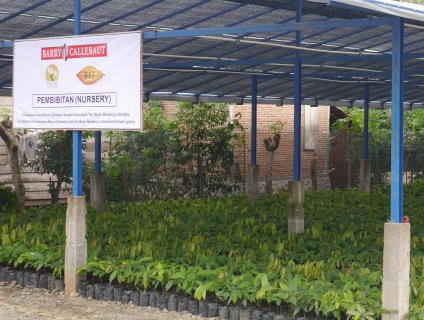One of Barry Callebaut’s primary goals in Forever Chocolate is to lift more than 500,000 farmers out of poverty. To get there, they improve farm productivity and increase the yield of high-quality cocoa.
Doing this will enable farmers to sell their cocoa at higher prices. The way to get more high-quality cocoa on the same amount of land is with better trees.
Barry Callebaut aims to deliver 500,000 seedlings from its cocoa nurseries to farmers in Indonesia in 2017 and is in the midst of trialling a range of interventions to produce the best trees.
Richard Fahey, Vice President for Cocoa in Asia and Indonesia-based Sustainability Manager, Ani Setiyoningrum, explain the project in a Q and A on the company's website.
Why do cocoa farmers need new trees?
Richard: Indonesia has been struggling to increase cocoa production because of ageing cocoa trees. Most of them were planted in the 1980s, are vulnerable to diseases and are well past their peak production years.
Cocoa trees are strong, and will produce pods for a long time. However, the high-productive years of a cocoa tree are finite, and usually after 25 years, the trees are less productive.
Indonesia desperately needs new trees to get back to a productivity level of around 1 metric ton of beans per hectare.
Why are cocoa nurseries important for our farmers in Indonesia?
Richard: Most Indonesian farmers simply have not had access to good planting materials and prefer to stick with their old trees rather than risk planting new trees that may or may not be effective.
High-quality nurseries are therefore are essential to give them the confidence that the seedlings they purchase will turn into high-yielding, disease resistant trees.
Ani: The purpose of cocoa nurseries is to provide a conducive environment in which young cocoa plants can grow a good number of leaves and fully develop its root system to a certain stage that will give cocoa plants a better chance of survival at the cocoa farm.
How are the company's cocoa nurseries different from others?
Ani: These are community-run nurseries. Our field experts work closely with these nurseries owners to teach them to produce high quality seedlings with a high survival rate.
They are given proper planting material, high-quality seeds, and the right potting mix and are guided to develop good nursery management skills and standard operating procedures.

Why will these seedlings provide a better yield than the existing trees?
Ani: Usually, cacao trees start in a nursery bed, where seeds from high yielding trees are planted in a polybag. The seedlings grow so fast that in three months they are ready for top grafting.
The grafting will ensure the tree carry the genetics of its mother tree. By selecting the budwood for grafting, new seedlings grow into more robust trees, and are able to reach maturity sooner.
These new seedlings start producing pods an average of 18 months after planting and are proven to have better survival rates.
To read the full Q and A, see the Barry Callebaut website.
